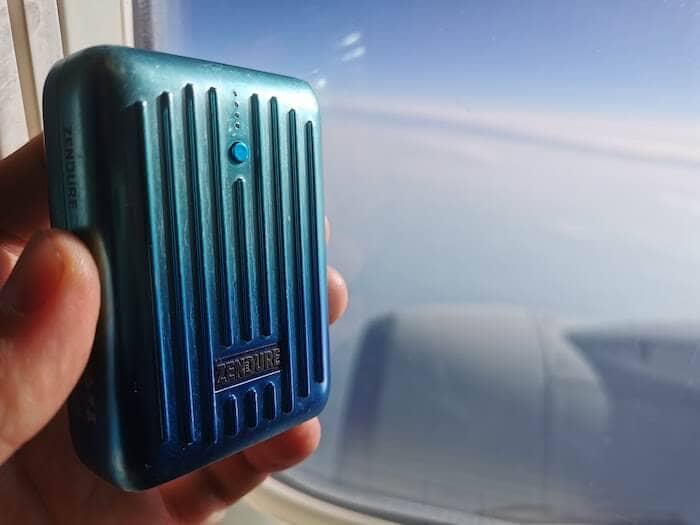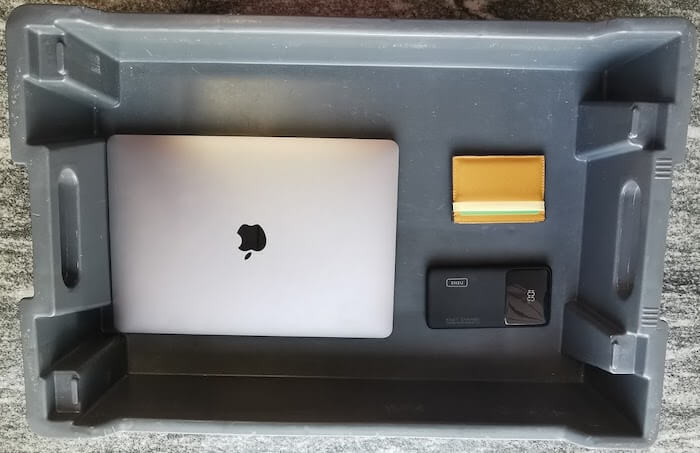We say “to be on the safe side”, because on the official site, United mentions two different maximum capacities for batteries:

As you can see on the print screen above, in the span of just two sentences they mention their maximum limits to be both 100Wh and 160Wh. This is why, to make sure you don’t run into trouble, we advise you to stick to the lower limit of 100Wh.
However, if you have a power bank or battery with a capacity between 100Wh and 160Wh, you may still be able to take it on a United flight. But in this case, we strongly suggest that you check with the airline before boarding, to get a specific approval.

How to Find Out the Wh Capacity of Your Power Bank
A watt-hour (Wh) is the estimated energy consumption of electrical equipment for an hour. Typically, the Wh is printed on the power bank, product packaging, or user manual. Certain items, however, are missing this information; in this case, visit our Wh calculator and enter the necessary values, including the mAh and Voltage of your power bank.
United Airlines’s Policy on Other Types of Rechargeable Batteries
General Purpose Batteries
The following batteries are permitted on United Airlines flights: AA-9V, AAA, C, Carbon zinc, D alkaline, Nickel-metal hydride, and Silver Oxide. These batteries may be transported in carry-on luggage or checked baggage. Their terminals should be covered and insulated to prevent short circuits.
Personal Electronic Devices
Personal electronic devices powered by lithium batteries are permitted to be packed in both carry-on and checked luggage, but their battery capacity should not exceed 100Wh, similar to power banks.
Electronic Cigarettes / Vapes
E-cigarettes and personal vaporizers are only allowed in carry-on luggage. They are not allowed in checked bags.
Mobility Equipment
Since most mobility equipment, such as scooters and wheelchairs, are powered by a high-capacity lithium battery, each passenger is permitted to carry two lithium batteries with a capacity of more than 100Wh but not exceeding 160Wh into the cabin.
Damaged or Recalled Batteries
Recalled, damaged, or defective batteries are strictly prohibited. For example, suppose you own a product that has been recalled by the manufacturer due to a defective battery, such as a MacBook Pro Retina display 15-inch laptop made between September 2015 and February 2017. You would not be able to travel with such a device.
Smart Bags
United Airlines prohibits smart bags with non-removable batteries. However, if the luggage is equipped with a detachable battery, you may take it out and carry it inside the cabin while the bag is checked in. To avoid a short-circuit, cover and insulate the battery terminals to prevent them from coming into contact with any metal items such as coins, keychains, and so on.

Rules and Recommendations for Using Battery-Powered Devices on United Flights
A phone or battery-powered item being stuck or lost within the seat assembly or aircraft structure is one of the most common accidents in airplanes. If this happens and you are unable to reach the device, do not attempt to adjust the seat assembly or the aircraft structure, and immediately inform the in-flight crew. Also, keep in mind that repositioning the seat may cause the device to break and catch fire.
Passengers on United-operated flights are always allowed to use electronic devices in non-cellular or “airplane” mode inside the United States (including its territories). Outside the United States, permitted devices may be used only above 10,000 feet unless the flight attendants announce that permitted devices may be used throughout the flight.
Remember to pay attention to flight attendant announcements about electronic devices, as they may request that you switch them off to avoid interfering with aircraft navigational systems. Furthermore, if the flight attendant asks that you turn off your portable electronic device, you should either hold it in your hand or place it in your seat’s pocket. If you have a large electronic device, such as a laptop, you must store it in an overhead bin or another permitted stowage area during takeoff and landing.
Why Are Airlines So Concerned With Batteries?
While batteries are efficient and power most modern devices, they can be extremely dangerous to the point of death due to their flammability and toxicity, particularly lithium batteries. According to FAA statistics on airplane battery incidents, Delta Airlines tops the list with 29 incidences, followed by Southwest with 36, United with 23, and American Airlines with 10.
Conclusion
Because of the limits related to air travel, it is always recommended that you read their policies before purchasing a ticket. Also, if an airline’s official website does not provide enough information about your situation, contact them since you may encounter issues while onboarding. If you’re wondering about FAA and TSA regulations regarding portable chargers, read this article: What types of power banks are allowed on a plane? 3 TSA rules you need to know.
